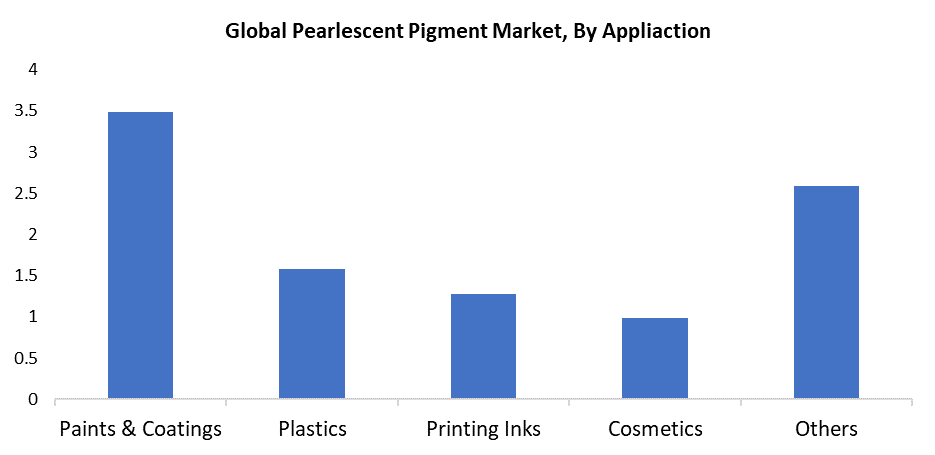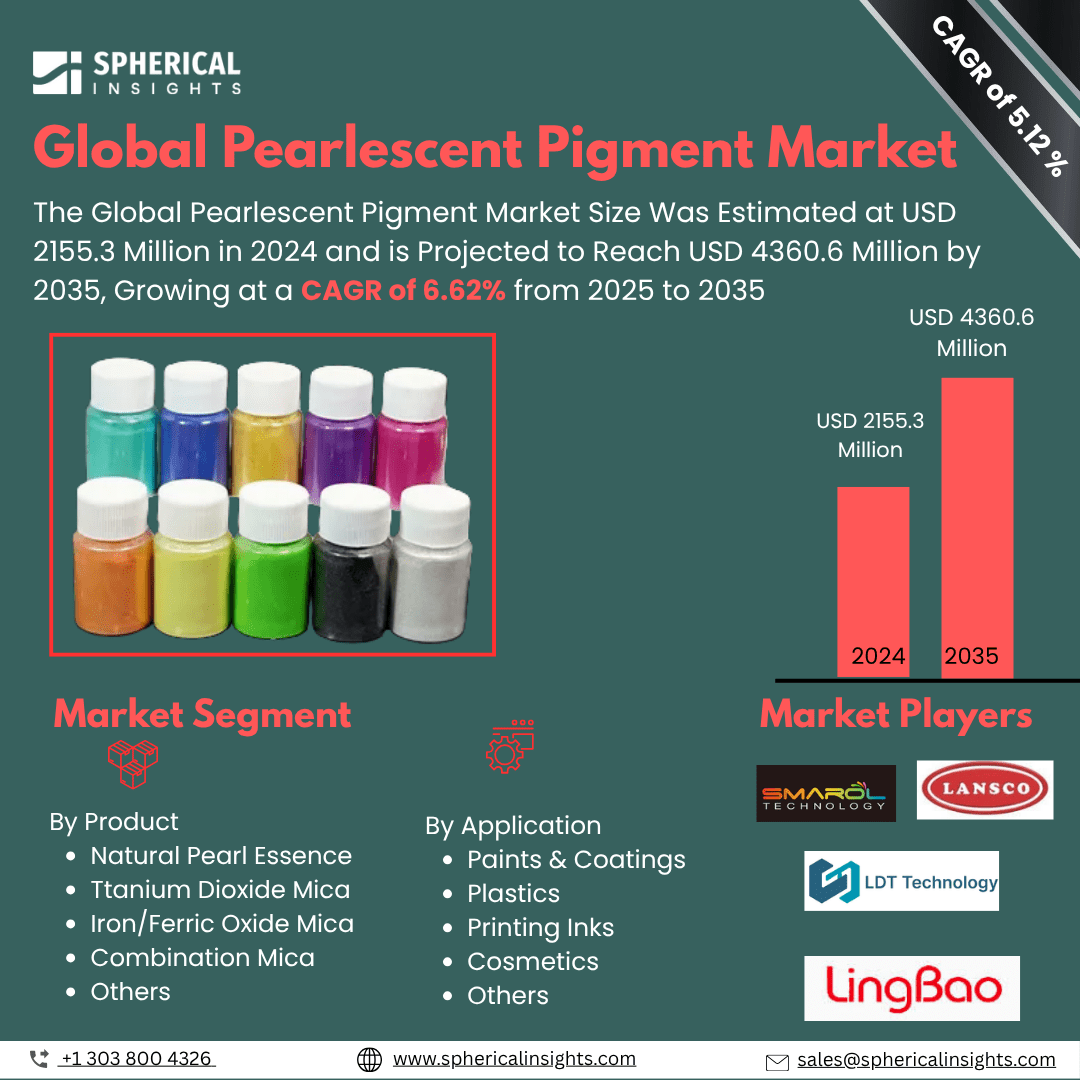Pearlescent Pigment Market Summary
The Global Pearlescent Pigment Market Size Was Estimated at USD 2155.3 Million in 2024 and is Projected to Reach USD 4360.6 Million by 2035, Growing at a CAGR of 6.62% from 2025 to 2035. A number of factors, such as growing consumer desire for aesthetically pleasing products, increased demand from the automotive and cosmetics industries, and technological breakthroughs that improve pigment performance, are driving expansion in the pearlescent pigment market.
Key Regional and Segment-Wise Insights
- In 2024, Asia Pacific held the largest revenue share of over 32.5% and dominated the market globally.
- In 2024, the titanium dioxide mica segment had the highest market share by product, accounting for 38.7%.
- In 2024, the paints and coatings segment had the biggest market share by application, accounting for 35.3%.
Global Market Forecast and Revenue Outlook
- 2024 Market Size: USD 2155.3 Million
- 2035 Projected Market Size: USD 4360.6 Million
- CAGR (2025-2035): 6.62%
- Asia Pacific: Largest market in 2024

The worldwide industry responsible for producing and distributing pearlescent pigments that generate iridescent effects through light reflection and refraction is part of the pearlescent pigment market. The market for pearlescent pigments has expanded significantly because customers need finishes with high gloss as well as color shifting and visual impact. The beauty and personal care industry demonstrates a distinct upward trend of pearlescent pigments because they create shining effects for skincare products, highlighters, and eyeshadows, which boost their marketability. The clean beauty movement and rising consumer demand for product transparency drive the adoption of ethical and sustainable raw materials, including biodegradable solutions and synthetic mica. New pigment technology enables greater use of environmentally friendly packaging alongside decorative coatings. Pearlescent pigments serve as essential components in product design because consumers and brands now value sustainability, usability, and aesthetic appeal more highly.
The industry demonstrates rapid expansion beyond cosmetics applications as it moves into luxury packaging, 3D printing, smart coatings, and automotive sectors. The automotive industry is adding pearlescent pigments to vehicle coatings because these pigments produce unique color-changing high-end finishes that match the rising interest in car customization. These pigments are compatible with both original equipment manufacturer and aftermarket operations since they perform well in solvent-based and aqueous coating systems. Packaging benefits from improved shelf appeal alongside sustainability goals through the implementation of recyclable or biodegradable formulations. The rising disposable incomes in developing nations generate strong potential growth opportunities. Pearlescent pigment market growth will continue globally because of innovative developments alongside environmental consciousness and expanding industry applications.

The titanium dioxide mica category led the pearlescent pigment market during 2024 by generating 38.7% of total revenue because of its outstanding optical properties, economical production, and versatile applications. These pigments are perfect for a variety of applications since they create a wide spectrum of interference colors, from delicate silvers to vivid hues, and a beautiful sheen when applied over mica flakes coated with titanium dioxide. The combination of high refractive index and superior UV resistance, chemical stability, and weather resilience enables these pigments to perform in both indoor and outdoor environments. The use of titanium dioxide mica provides products with shimmering and iridescent effects that find application in cosmetics, packaging, as well as automobile coatings, ornamental paints, and plastic materials. The market success of this product relies on its ability to deliver stable visual appeal and enduring color effects.
The "Other" product segments in the pearlescent pigment market will experience the fastest growth during the forecast period because of their rising specialized applications. Natural pearl essence pigments face declining popularity because of ethical issues and limited supply. The warm metallic tones of iron/ferric oxide mica substitutes are gaining popularity as replacements for natural pearl essence pigments in color cosmetics and industrial coatings. Luxury consumer items and automotive finishes increasingly use combination mica pigments, which blend different elements to produce premium visual effects. Synthetic mica and bismuth oxychloride-based pigments demonstrate rapid growth because they match sustainable product formulations and meet customer preferences for ethical ingredient sourcing, especially within clean beauty and eco-friendly product categories.
Application Insights

The paints and coatings segment led the pearlescent pigment market during 2024 by achieving 35.3% of total revenue because of its broad industrial, architectural, and automotive applications. Pearlescent pigments maintain strong demand among customers who want high-end and special finishes because these pigments deliver three-dimensional brilliance and shimmering effects. Pearlescent pigments enable automakers to develop distinctive luxury and electrified vehicles, which enhances brand distinction in the market. The growing demand for protective and decorative coatings across residential and commercial buildings, primarily in Asia Pacific and the Middle East, drives the market expansion forward. The usage of pigments has grown because of the introduction of low-VOC coatings, which are environmentally friendly. The segment will experience continuous growth because its ability to deliver unique color effects and enhanced performance qualities makes it highly attractive to customers.
The other application areas grow at a significant rate in the pearlescent pigment market during the forecasted period. Manufacturers apply these pigments to enhance the visual appeal of consumer packaging and cosmetic containers as well as domestic goods within the expanding plastics market. The growing importance of printing inks exists in packaging and labeling for pearlescent pigment applications that provide branding and security features. The cosmetics industry experiences major expansion because consumers seek both sustainable formulas with clean labels and luminous, radiant skin results. The specialized industries, including 3D printing, ceramics, and textiles, experience growth through pearlescent pigment applications to develop unique visual effects and innovative product designs. The numerous applications together enable the market to increase its reach and development potential.
Regional Insights
The North American pearlescent pigment market accounted for 30.2% of total revenue in 2024 because the industry experienced strong demand for premium decorative applications across home décor, packaging, cosmetics and automotive coatings. The market adoption of environmentally safe pigments, together with synthetic mica, has risen because of strict regulations and innovation-focused strategies in the region. The established industrial base of the United States and Canada maintains steady demand from both consumer and industrial markets. The growing preference for visually appealing and environmentally sustainable products has led to higher pigment consumption because of enhanced production methods. Product development continues to grow because of persistent research investments and increased focus on environmentally safe formulations. The global pearlescent pigment market finds its strongest position in North America because major market players operate in the region alongside well-developed infrastructure systems.
U.S. Pearlescent Pigment Market Trends
The U.S. pearlescent pigment industry led the North American market due to its advancement in the automotive, personal care, and packaging sectors during 2024. Consumer demand for luxurious finishes and attractive designs, especially in cosmetics and premium coatings, drives the market expansion. The country has become an innovation hub because of its strong research capabilities and multinational corporate presence, combined with strict regulations that support sustainable material usage. The expanding applications stem from the rising use of pearlescent pigments in vehicle coatings for luxury and customized finishes, as well as decorative and industrial paints. The expanding market demand results from the increasing consumer electronics market, together with the plastics packaging industry. Internet retail accessibility, combined with the transition to non-toxic and environmentally friendly pigments, makes products more visible to consumers. Pigment adoption gains momentum through regulatory initiatives, which promote safer cosmetics, thus maintaining steady growth of the market.
Asia Pacific Pearlescent Pigment Market Trends
The pearlescent pigment market is led by the Asia Pacific region by holding a 32.5% revenue share during 2024, because of its strong growth in packaging, along with the construction, automotive, and cosmetics sectors. The region's substantial manufacturing facilities, combined with an affordable workforce and rising infrastructure expenditures, help drive this expansion. High-end consumer goods, along with personal care products and decorative coatings, find their demand growing because of China's and India's urbanization and their neighbors' increasing disposable incomes. Specialty pigments are finding rising application in automotive exteriors and interiors because electric vehicles have become popular. The expanding middle-class population creates more need for flexible packaging, together with premium cosmetics. The electronics industry in Asia Pacific continues to expand because it uses pigments to create premium device finishes, which drives market growth. The implementation of government initiatives for homegrown production creates local market needs that boost Asia Pacific's market leadership position.
Europe Pearlescent Pigment Market Trends
The European market accounted for 12.3% of revenue in the pearlescent pigment market in 2024 because of its strict sustainable and ethical product regulations. The region leads the industry in applying synthetic, environmentally friendly mica-based pigments for packaging applications, automotive coatings, and cosmetic products. The market experiences growth because customers seek premium, environmentally friendly products, and companies maintain advanced production and research capabilities. The luxury packaging sector in France, Germany, and Italy generates fresh market prospects, while architectural coatings benefit from rising customer interest in premium finishing solutions. The green building certification movement and sustainable coatings drive additional market expansion. The European market experiences steady growth due to developments in eco-friendly printing inks and automobile aftermarket interest in custom refinishing applications.
Key Pearlescent Pigment Companies:
The following are the leading companies in the pearlescent pigment market. These companies collectively hold the largest market share and dictate industry trends
- Huaian Concord Cosmetics Product Co., Ltd. (Kolortek)
- Smarol Technology
- Sun Chemical Performance Pigments
- Geotech International B.V.
- Lansco Colors
- RIKA Technology Co. Ltd.
- L’Arca Srl (Arca Colours)
- Fujian Kuncai Fine Chemicals Co., Ltd.
- Nanyang Lingbao Pearl Pigment Co. Ltd.
- BASF SE
- Pritty Pearlescent Pigments and Brenntag Specialties Inc.
- Others
Recent Developments
- In March 2025, Sudarshan Chemical Industries Ltd. (SCIL) completed the acquisition of Heubach Group through its European division, Sudarshan Europe B.V. The transaction strengthens SCIL's pigment business while expanding its worldwide operations to 19 locations.
- In March 2025, at ECS 2025 in Germany, ECKART presented cutting-edge pigment advancements. Highlights included low-carbon aluminum pigments, metallic rainbow and chrome dispersions, corrosion-resistant zinc pigments, radar-transparent coatings for driverless cars, and environmentally friendly printing inks.
Market Segment
This study forecasts revenue at global, regional, and country levels from 2020 to 2035. Spherical Insights has segmented the pearlescent pigment market based on the below-mentioned segments:
Global Pearlescent Pigment Market, By Product
- Natural Pearl Essence
- Titanium Dioxide Mica
- Iron/Ferric Oxide Mica
- Combination Mica
- Others
Global Pearlescent Pigment Market, By Application
- Paints & Coatings
- Plastics
- Printing Inks
- Cosmetics
- Others
Global Pearlescent Pigment Market, By Regional Analysis
- North America
- Europe
- Germany
- UK
- France
- Italy
- Spain
- Russia
- Rest of Europe
- Asia Pacific
- China
- Japan
- India
- South Korea
- Australia
- Rest of Asia Pacific
- South America
- Brazil
- Argentina
- Rest of South America
- Middle East & Africa
- UAE
- Saudi Arabia
- Qatar
- South Africa
- Rest of the Middle East & Africa






